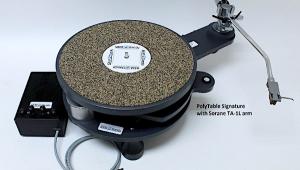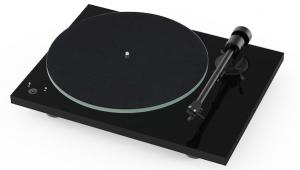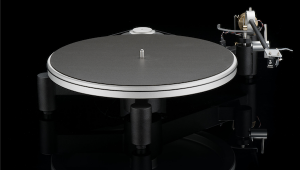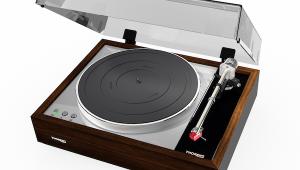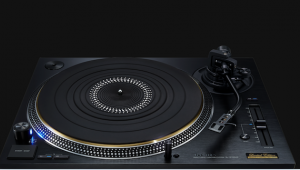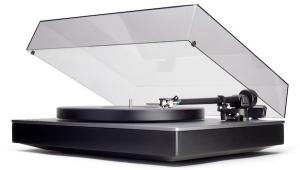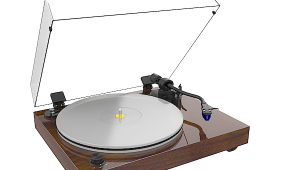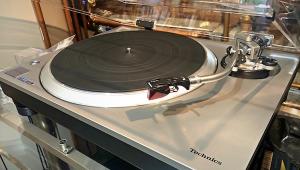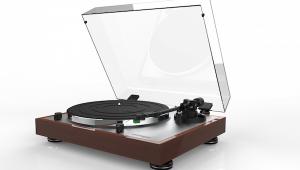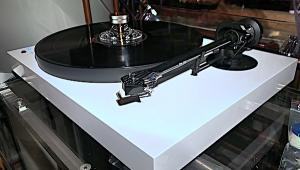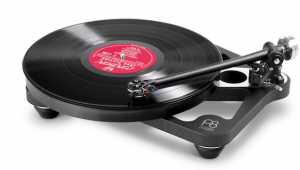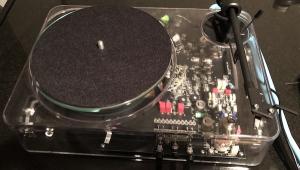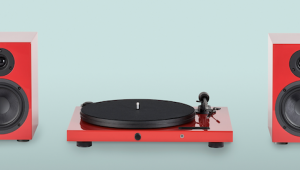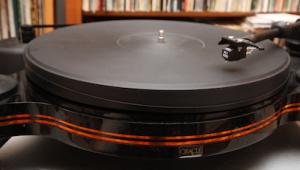Rega Gives the Popular 3 Series A New Spin With the Planar 3 (Decimal Point Added)
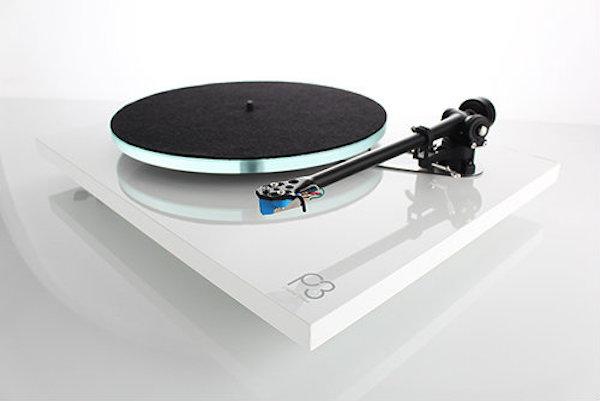
Can any turntable manufacturer be enjoying the vinyl revival more than Rega? I doubt it. It saw compact discs coming and yet spent a considerable amount of money creating a tool to produce cast pick up arms. I keep mentioning this in Rega reviews but in the face of the digital onslaught it demonstrates their determined commitment to vinyl playback.
Having made that casting investment gave Rega a “leg up” (or an arm up) against the competition and it served them well for years and still does today.
In the mid-nineties vinyl started its serious fade but so confident was Rega that it built a new 30,000 square foot factory and expanded its product line to include a full line of electronics including CD players amplifiers and loudspeakers, but the company always kept turntables in the lineup and not as an afterthought or as an exercise in nostalgia.
Research and development continued, though the company has long stuck to its core beliefs in tone arm rigidity over adjustability, and light weight over high mass.
So one can look at the new Planar 3 ($945 w/o cartridge, $1145 with pre-mounted Elys 2 MM cartridge) and because it outwardly looks similar (if not identical at a quick glance) to older Rega ‘tables, wrongly conclude that it’s more of the same.
In fact, other than a few carried over parts, the new Planar 3 is a brand new design, starting with the new RB330 tone arm, which was developed using 3D CAD/CAM technology that provided previously unavailable answers for where mass should be distributed, resonances decreased and stiffness and strength increased.
The newly developed vertical bearing housing ups the stiffness while lowering the mass. The updated tracking force adjusting spring housing allows for more precise adjustability down to .1gram without using an external gauge. There are new vertical and horizontal bearings and a new 100 gram milled steel counterweight.
The new magnet-based anti-skating housing simplifies the adjustment. Finally, there’s a new low capacitance Rega-manufactured wiring harness fitted with Neutrik plugs and a new locking arm holder for the 227mm effective length arm.
A revised plinth of a higher grade MDF than previously used is now finished with a high-pressure bonded high gloss acrylic skin on top, under which is a phenolic brace, and on bottom a thicker 3mm phenolic brace, thus producing a rigid sandwich.
The twin phase 24V motor’s performance has been improved with a new motor controller printed circuit board that allows greater assembly accuracy and is said to eliminate potential on-board component damage.
Santoprene (a thermo-plastic elastomer) feet are wider in diameter and lighter than previous feet, which is claimed to improve stability and provide greater isolation.
The platter is of a new Optiwhite glass material that can be more accurately machined and also looks better. Rega claims it aids in “pure gyroscopic operation of the platter, hub and bearing assembly”, which the company claims also lowers noise and increases speed accuracy.
The platter rides on a new hub and main bearing assembly. The new “compression-free” bearing housing is a patent-pending design that ensure perfect perpendicularity to the plinth and optimal torque. The hub itself (the sub-platter) has been completely re-designed using Makrolon, a new high-strength, glass impregnated polycarbonate that’s stronger, lighter and more easily machined than was the previous material. The new hub also has more platter contact points, which means it better mates with the platter.
The new assembly is said to stop potential energy transfer from the platter/hub into the plinth and so “dramatically” lower noise and increase detail resolution.
In other words, other than the motor, the dust cover and the felt mat, the Planar 3 is a completely new design, based upon tried-and-true previous designs and proven technology.
Options
Rega offers a $59 “Ref” belt upgrade and a $395 TT PSU outboard power supply upgrade, the latter of which is standard on the far more expensive RP6. Along with claimed better speed control, it allows you to change speed at the push of a button rather than removing the platter and changing belt position on the stepped pulley.
I ran the ‘table exclusively with the upgraded belt and listened and measured using both the basic “walwart” power supply and the TT PSU.
Fool Proof Set-Up
When someone asks me about a starter turntable prices at “around a grand”, the Rega with Elys MM cartridge pre-installed comes immediately to mind.
First of all it’s among the easiest ‘tables to set up out of the box: place on a level surface, run the belt around the pulley and sub-platter, rest the platter with felt mat on the sub-platter and then put the counterweight on the arm stub and twist until the arm balances. Add the VTF using the spring-based adjuster and then the anti-skate setting to match tracking force and after plugging in the power supply and signal cables, you’re ready to go. Takes but a few minutes.
I don’t have an older Rega on hand to compare with this latest iteration, but I have a pretty good sonic recall. I started with The remarkable Elvis Way Down In the Jungle Room (RCA/Legacy) a two LP set of some of Elvis’s final recordings produced using RCA’s remote truck parked outside of Graceland. The sound (no doubt 96/24 sourced) is remarkably natural and transparent and I’d played the two LPs numerous times on the “big rig”. The phono preamp’s included the Lejenklou Gaio, among others that will be part of an upcoming “you listen, you decide” phono preamp survey. w
The Planar 3’s rendering of this “live in the living room” record (with the $295 Elys MM cartridge) demonstrated the ‘tables rhythmic punch and solid bass performance. No, it didn’t “plumb the depths” but the bass that was there, was reasonably well-developed and started and stopped more quickly than I remember from the previous iteration of the Rega 3. There was less “plinth induced overhang”, which also produced a finely rendered, three-dimensional “Elvis in the room”.
Tapping with the stylus in the groove of a non-turning platter demonstrated a far stiffer and better braced, less lively plinth than the previous generation, which sounded more like tapping on a window pain.
I played a mono copy of Bossa Nova Pelos Passaros (Riverside RM436) which on many tracks features the guitarist with his trio of Keter Betts on bass and Bill Reichenbach on drums—the same core group that played on the groundbreaking Jazz Samba released on Verve the same year (1962).
The ‘table’s (or the ‘table’s and cartridge’s) performance on this record was especially impressive in articulating the guitar’s warm sound without it getting lost in the bass, which remained well-articulated and impressively solid.
The overall sound of the ‘table with supplied cartridge and “Wal-wart” power supply was warm in the mids, but less than fully clarified on top. After spending a day listening to the “basic” ‘table and cartridge, I plugged in the $395 TT PSU and again played the Charlie Byrd album, which I thought would be a good indicator of what the power supply might or might not do (though I also measured).
The difference was not subtle! Byrd’s guitar was more cleanly delineated in the mono space, and his string plucks were better articulated. The soft snare hits were so better clarified and focused in space and the bass, which already was quite good, was even better articulated.
Overall what had been a very pleasant, warmish but reasonably well articulated mush, became a far more clarified picture in every way. A few tracks on the Byrd album include a trombone, flute and alto sax. These all congealed with the ‘table plugged in via the Walwart. With the TT PSU power supply the instruments separated in space and were noticeably better articulated.
Perhaps if you are buying this ‘table you should just go the extra $395 when you do, though an argument could be made for living with it for a while to hear if you wish to further invest in it or go upmarket. My opinion is that you give up so much by powering the Planar 3 with the Walwart, it makes sense to start with the TT PSU if at all financially possible. The differences were not subtle on every record I played.
Cartridge Swap
How much of what I heard was the ‘table and how much was the cartridge? It’s difficult to separate the two without changing cartridges. While the sound with the Elys2 was what about I’d expect from a $295 cartridge—more midrange and less resolving on top, with slightly boxy low frequencies— I wanted to hear how the ‘table responded to one costing far more.
I chose the $1495 Audio-Technica AT 150ANV, which costs a bit more than the ‘table with upgraded power supply ($1549). This is a really superb, high-tech MM cartridge featuring a sapphire cantilever to which is attached a Micro-Linear shaped stylus. In the blind test we conducted with you, it got the most votes.
You could say that was overkill but what it told me was that the Planar 3 can really sing with a better cartridge than the Elys2. The top end in particular was vastly improved not only in extension, but especially in resolution and a less “mechanical” quality that resulted in a velvety smooth sound plus greater overall resolution—I’m not sure the older 3 would have been able to appreciate and deliver all of this resolution particularly at the lower end of the dynamic scale. And the bottom end had more “sock” and slam that the ‘table handled very well.
When I played Kansas City Suite-Count Basie & His Orch. The Music of Benny Carter(Pure Pleasure/Roulette PPAN SR52056) recorded at United in Los Angeles, Eddle Jones’s monumental bass was more powerful and well articulated than I’d been expecting and the overall dynamic swagger was equally impressive. However, the top end was muffled and everything was distant.
Then I played the version of the same song on the Mosaic LP box set The Complete Roulette Studio Recordings of Count Basie And His Orchestra (Mosaic MQ15-149) and even though it was a compilation the orchestra brass was so much more open and appropriately brash. Lately, Pure Pleasure has put out some really questionable sounding releases like this one.
However, given the right recordings, the Planar P3 (especially with the super-expensive cartridge) sounds far more accomplished than its price tag would lead one to believe it can perform. I also played a just reissued by Analogue Productions version of Winds of War and Peace (APC 8823) originally issued by Wilson Audio in 1988 and engineered by Wilson Audio Specialties’ Dave Wilson. It’s a recording of the National Symphonic Winds, which I believe is a military outfit. The conductor Lowell Graham spoke about the recording at an audio show a few years ago, explaining that the enormous bass “thwacks” were produced by a large, floor standing drum hit with what he called “The Mallet of Death”.
When I played a high rez rip of this track at a Consumer Electronics Show a few years ago, the “thwack” literally vaporized a speaker’s ceramic midrange driver! I played the reissue on the Planar 3 (with the Audio Technica cartridge) wondering how it would reproduce that big bass hit and I was rewarded with an impressively deep, solid and strong “thwack” that I don’t think the older 3 could have managed (though admittedly without actually hearing it that’s pure conjecture).
Measurements
Using the Platterspeed app, I first measured the ‘table plugged into the “Walwart” power supply. Here are the results:
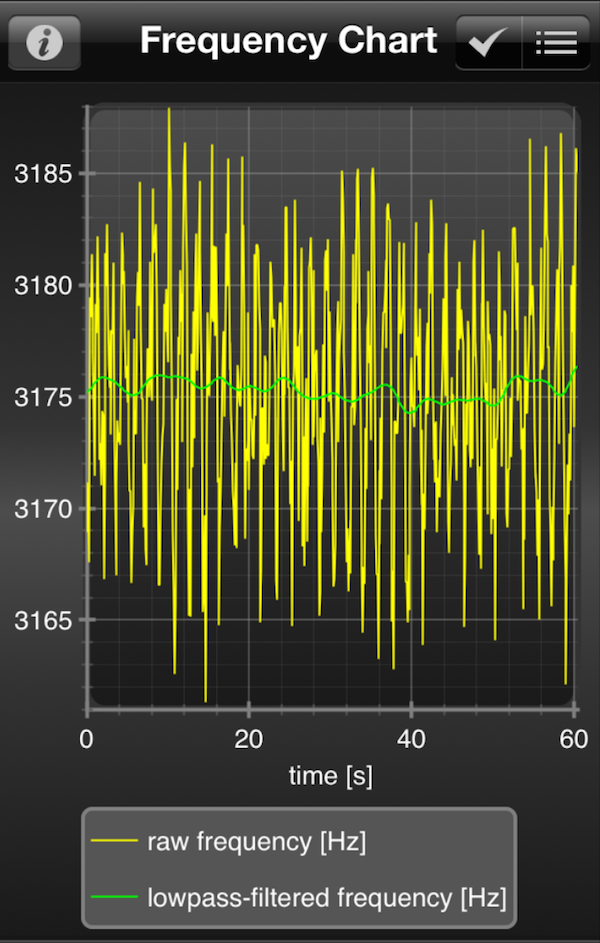
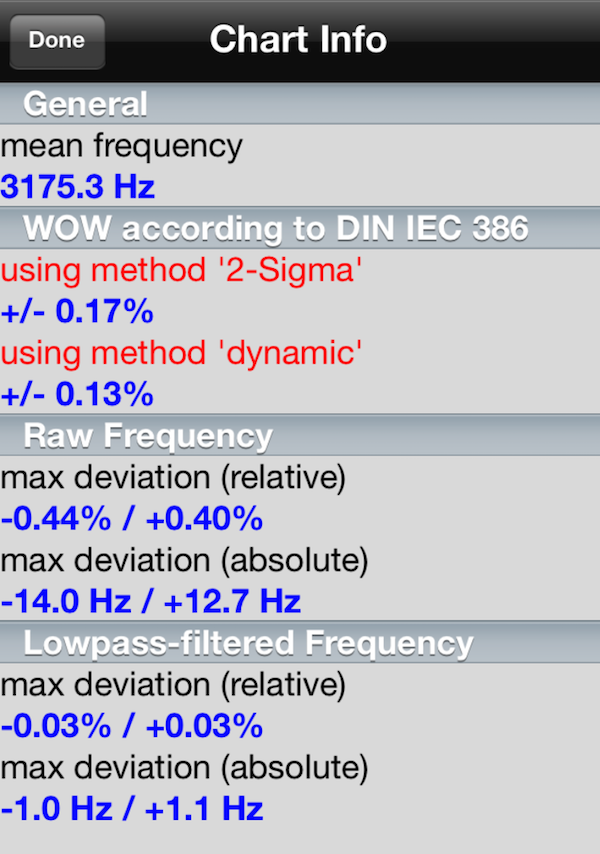
The test tone is at 3150Hz, which is not even visible in the graph because the turntable spins more than .2% fast. I had been expecting that because Rega runs their ‘tables fast. They might deny it, but every one I’ve reviewed has run slightly fast.
The low pass filtered green line shows the 3150Hz tone reproduced at approximately 3175Hz. The yellow shows the raw frequency performance that also includes eccentricity caused “wow”.
The second image shows you mean frequency of 3175.3, wow of ± 0.17% and 0.13%. Low pass filtered, the maximum relative frequency deviation was ±0.03 while the absolute deviation was -1.0%/+1.1Hz. The relative consistency of the green line is impressive and rivals the performance of some far more expensive 'tables I've reviewed.
Next, look at the same measurements with the TT PSU installed:
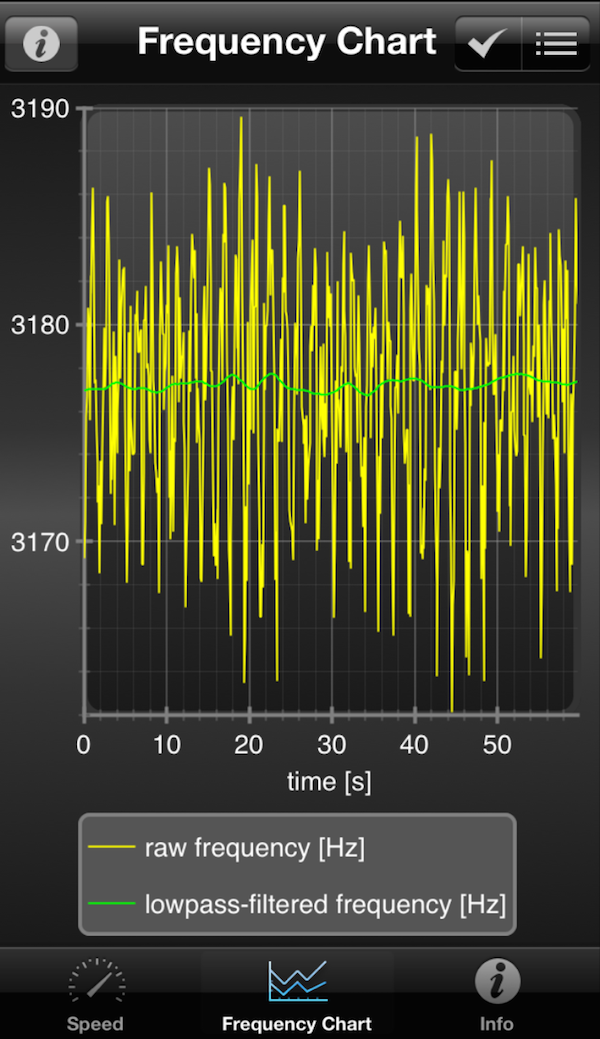
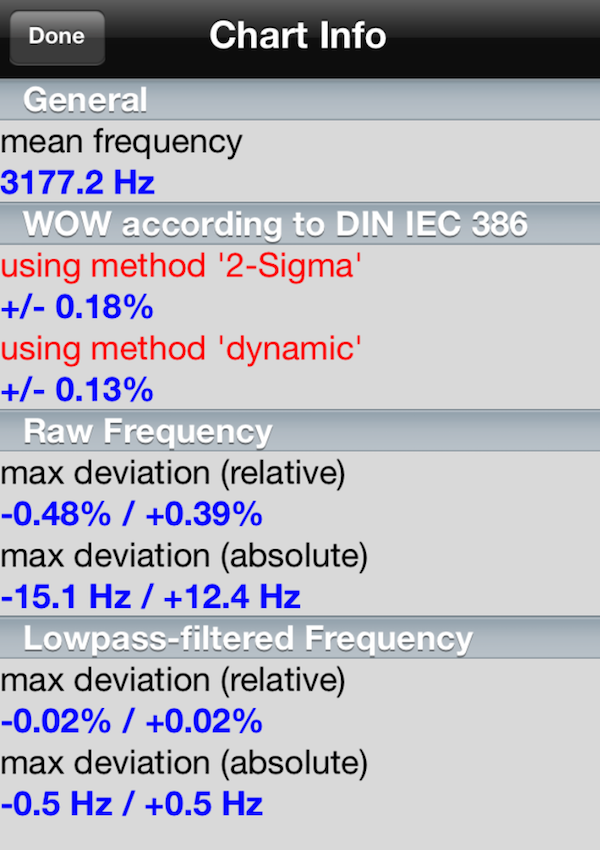
You’ll note that with the PSU, the ‘table ran slightly faster but also that the green line is smoother and flatter, demonstrating the PSU’s effectiveness. Also note that while the “Wow” and raw Frequency measurements were not all that different, the low pass filtered maximum deviations both relative and absolute were better. In fact, the absolute deviation from speed was halved via the PSU. More importantly you can easily hear the difference.
So what does it mean that the turntable runs slightly more than .2% fast in terms of what you hear? So yes, a 3150Hz tone is reproduced with a mean frequency of 3175.3 Hz (or 3177.2 Hz) but what if any are the sonic consequences of that?
I played a 440Hz test tone (440Hz is the musician’s “yard of A” above “C” that conductors use to “tune up” the orchestra) and used a digital voltmeter with a frequency function and measured 444Hz. So how much of a sonic pitch difference does that make? Interestingly someone has posted a comparison on YouTube and you can listen for yourself. They have also posted the two tones simultaneously.
But why would someone post that? If you go to the link found on that YouTube page you’ll find something so bizarre, creepy and grotesquely anti-semitic, related to 440Hz vs. 444Hz that I just had to alert you to it! Not that I think the 'table is set to run at 444Hz for a 440Hz tone for some nefarious purpose!
Back to the review: the ‘table runs slightly fast but unless you have perfect pitch you’re not likely to notice it. What it probably does though, is add a subliminal dose of “toe tapping” excitement with no other harm done. Still, I prefer turntables to run at the right speed (it’s indicative of the poor state of audio reviewing that most turntable reviews don’t bother telling you if the one being reviewed runs at the right speed).
Conclusion
The new Rega Planar 3 is a deceptively simple, high performance, high build quality, moderately priced turntable that is easy to set-up and even easier to use (be sure to place it on a level surface). It’s among the best, if not the best circa $1000 turntables currently available.
It showcases what analog does best, just giving you less of what’s possible from the very best, in a well-balanced presentation that might surprise you with how well it can deliver deep, well controlled bass and rock-solid image stability.
No, you cannot easily adjust VTA/SRA or azimuth but at this price point, rigidity is preferable to “loose” adjustability (Rega does manufacture shims that allow you to raise the rear of the arm to increase VTA/SRA, but there’s no way to decrease it from whatever it is “out of the box”).
While buying it with the pre-installed Elys2 cartridge makes it even easier to buy, unbox, set up and use, the 3’s arm is so good you ought to consider from the start stepping up to a higher performance, more expensive cartridge if you want to hear the Planar 3’s full capabilities.
One gripe: because the arm's effective length of 227mm is so unusual, you are limited to either the paper overhang gauge supplied with the 'table (Rega doesn't specify the geometry used, but previous ones were for Stephenson, which I regard as the least useful for popular music in terms of the distortion curve—and it's not that much better for classical music IMO) or to a "universal" gauge like the Feickert, which, in order to get an accurate setting, requires you to carefully set the pivot to spindle distance. Unfortunately Rega arms do not mark at the top of the arm, the location of the horizontal pivot, which makes difficult using such a gauge.
The Planar 3’s combination of easy set-up, high build quality, reasonable price and attractive sonic performance make it easy to recommend in the $1000 price point. The $59 Ref belt and especially the $395 TT PSU seriously upgrade the 3’s sonics and are highly recommended.


